Content [show]
Marigolds, lights, hats, black-haired men - this is how the tagetes are affectionately called. This universal favorite grows quickly and is unpretentious in care. Among its varieties are dwarfs and giants. And even beginners can grow marigold seedlings with their own hands
Useful properties of marigolds
Tagetes inflorescences vary in size and shape from small “carnations” to luxurious “chrysanthemums”, and colors from lemon yellow to red-brown. Marigolds are planted in flower beds, in containers, they are conveniently used to cover places that are bare after the flowering of bulbous crops. Tagetes is suitable not only for garden decoration. All parts of the plant contain phytoncides that repel pests and inhibit disease-causing fungi, including those living in the soil. Marigolds are planted on strawberries from a weevil, on cabbage to scare away a whites, next to asters - from fusarium, near phlox and clematis for the prevention of nematodes. Tagetes is used as a medicinal plant and as a spice.
When to sow marigolds for seedlings?
Tagetes propagated by seeds. They can be sown into the ground after the end of the frost, and then thin out or plant the seedlings more freely, but you can plant tagetes with flowering seedlings immediately after the end of the frost.
From germination to flowering of tagetes, it takes from 40 to 50 days, depending on the variety, therefore it is necessary to sow marigolds for seedlings in the first decade of April. The soil for sowing tagetes should be sufficiently fertile and loose. Such a land mixture is suitable: peat, humus (or compost), washed sand (2: 1: 0.5).
Sowing tagetes for seedlings Tagetes seedlings often die from the black leg. To prevent this from happening, a container filled with a soil mixture must be spilled in advance with a fungicide solution (Maxim, Vitaros, Fitosporin) or a dark pink solution of potassium permanganate. The best result is obtained by steaming the sifted soil mixture in a double boiler for an hour. In addition to the spores of pathogenic fungi, this will also destroy weed seeds. After lightly compacting the steamed potting mix, make shallow grooves on the surface. The soil should be slightly damp.
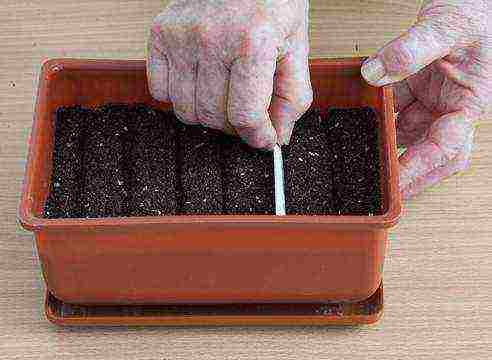
Spread the marigold seeds evenly over the grooves. This is most conveniently done with a small piece of white paper. If there are too few seeds, you can spread them out with tweezers. Label the varieties.

Sprinkle the crops on top with the same soil mixture with a layer of about 1 cm.With smaller sowing, the seed coat remains on the cotyledon leaves during germination, the marigold seedlings cannot shed the peel, which interferes with their further development.

Moisten crops. Try to do this carefully, without eroding the top layer of the soil, so that the seeds do not end up on its surface.
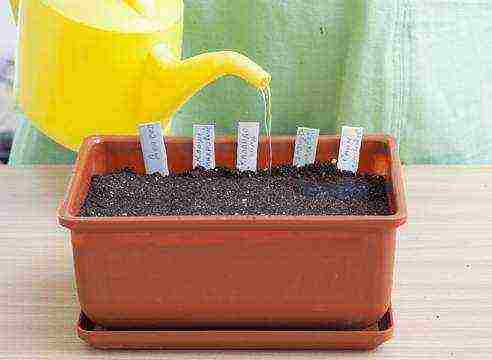
Cover crops to keep the soil moist at all times. For this, it is convenient to use a suitable lid from the food container. You can simply put the container with crops in a clean plastic bag and put it away in a bright place. At a temperature of + 15 ... + 20 ° C, marigold shoots appear in 5-7 days. The temperature regime is important, because at temperatures below + 15 ° C, the seeds germinate poorly, and if it rises above + 25 ° C, they do not germinate at all.
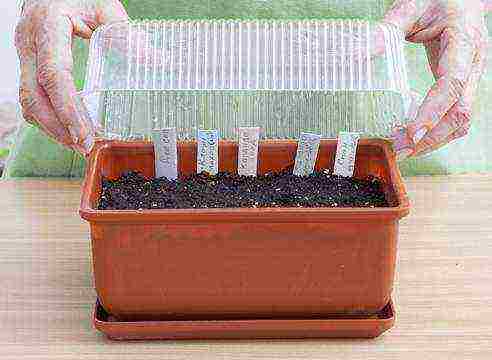
After the appearance of the first shoots, daily ventilation is necessary: at this time, the danger of the appearance of a black leg on the seedlings is highest. If you notice the first signs of the disease, immediately remove the lodging seedlings along with lumps of earth, and sprinkle the holes with fresh soil mixture and re-treat the crops with a fungicide solution.
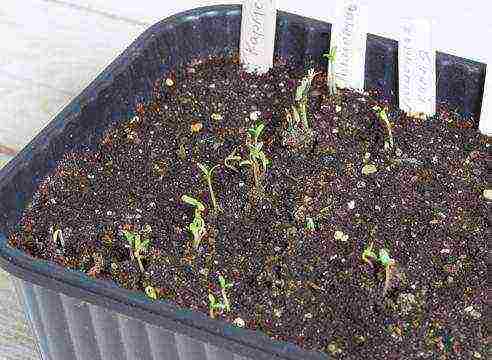
When friendly shoots appear, the shelter must be removed completely. Water after the soil in the container is completely dry, making sure no water accumulates in the pan. Once every two weeks, feed the seedlings with fertilizer for seedlings (Fertika Lux, Agricola, Solution).

After the appearance of 2-3 true leaves, the seedlings are ready for a pick.

Tagetes picking Tagetes dive at the stage of two true leaves. The seedling can be buried almost to the cotyledons (lower oblong leaves), but so that they do not touch the soil.
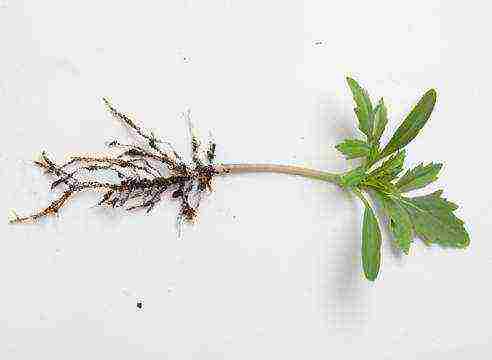
You can cut the marigold seedlings simply into the seedling box. Tagetes seedlings tolerate transplanting well even in flowering form - it is not necessary to keep the root ball at the same time. But it is most convenient to grow marigold seedlings in cassettes. The soil can be used with the same composition as for sowing, but without sieving. Add to it 1 tablespoon of a mineral fertilizer containing nitrogen, phosphorus and potassium, and 0.5 cups of wood ash for every 5 liters of the mixture. In order for fertilizers to be evenly distributed in the soil, you need to mix it thoroughly.
Fill the cassettes with the mixture, compact it a little, make depressions so large that the roots fit freely in it. If the roots are too long, they can be shortened a little. When diving, the seedlings need to be deepened by 1 cm.
Water gently. If the soil has settled too much after watering, top up the potting mix. Water regularly after the soil dries. The golden rule for tagetes: it is better not to add a little, than to pour.
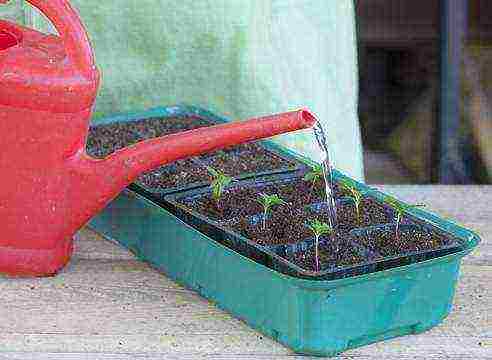
Planting tagetes in the ground Two weeks before planting, start gradually accustoming the seedlings to fresh air. Marigolds do not tolerate even minor frosts, therefore, seedlings can be planted only when their threat has passed. In the middle lane, this is usually the end of the first decade of June. Choose a sunny place. Although tagetes can grow in partial shade, it will bloom there much worse.

Tagetes does not require fertile soil, the main thing is that it is loose and air- and permeable, without stagnant water. Heavy clay soil will help improve peat and sand.
Dig the soil onto a shovel bayonet, apply a full mineral fertilizer (nitroamofosk, amofosk) at the rate of 30 g per 1 sq. m, embed it in the soil by secondary digging.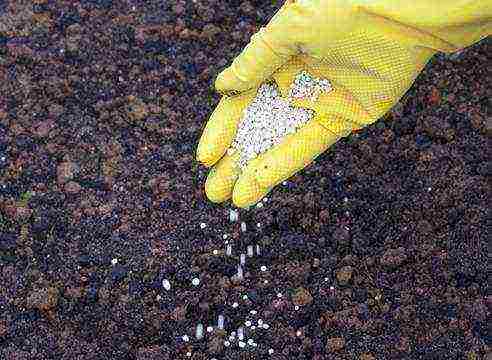
Prepare the holes 15-30 cm apart depending on the future size of the plants. Typically, the seed producer indicates on the bags the recommended distance for each variety. Therefore, it is important to keep the seed bags and label the seedlings with the names of the varieties. So you will know exactly at what distance to plant each variety of marigolds. Do the depth of the hole so that when planting, the stems can be deepened by 1-2 centimeters. Place the root system in the hole.
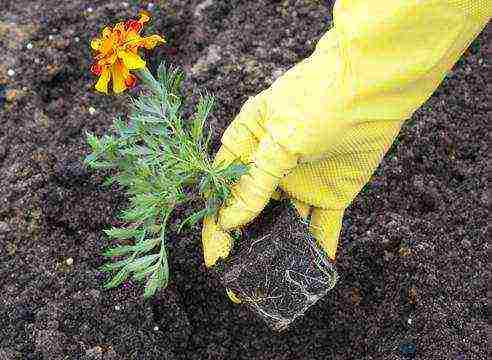
Thoroughly fill in the voids around the roots and compact a little.
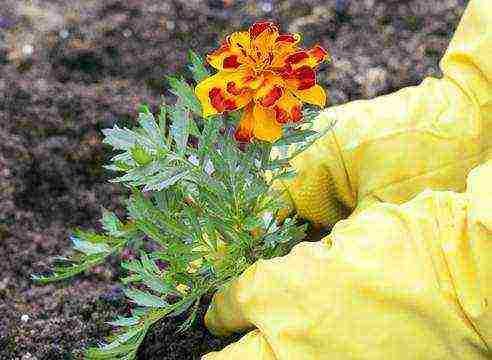
Water the planted seedlings. Tagetes is not afraid of watering over the leaves and rain. Further care consists in weeding and keeping the soil loose. If you have filled the soil with mineral fertilizers, then it is enough to feed Tagetes 1-2 times with phosphorus-potassium fertilizers per season. These elements contribute to a more lush flowering. With an excess of nitrogen, tagetes grows strongly to the detriment of the formation of new buds.
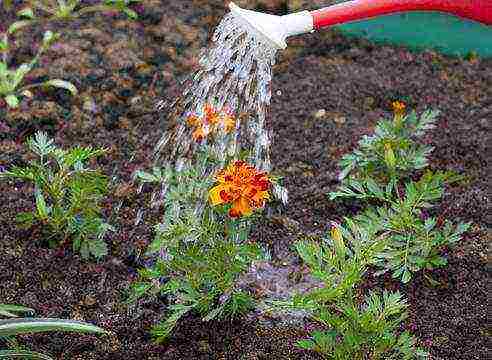
Go to the main article about tagetes
 Marigolds are one of the favorite annuals among gardeners. Lush bushes with carved foliage and bright flowers can be found on almost every site, emitting a spicy aroma familiar from childhood. Velvet flowers bloom almost all summer, delighting with an abundance of inflorescences.
Marigolds are one of the favorite annuals among gardeners. Lush bushes with carved foliage and bright flowers can be found on almost every site, emitting a spicy aroma familiar from childhood. Velvet flowers bloom almost all summer, delighting with an abundance of inflorescences.
Description of the plant
 Marigolds, or tagetes, belong to the genus of annuals and perennials in the Aster family. Erect branched stems form a bush with a height of 20 to 120 cm. The leaves are feathery, openwork, the root system is fibrous. Inflorescences are baskets, simple or double, yellow, orange or brown. Abundant flowering from mid-summer to frost. The fruit is achene, 1 g contains up to 700 seeds. The whole plant emits a spicy aroma. It grows best in sunny places, although it tolerates a little shade. The soil should be nutritious, moderately moist.
Marigolds, or tagetes, belong to the genus of annuals and perennials in the Aster family. Erect branched stems form a bush with a height of 20 to 120 cm. The leaves are feathery, openwork, the root system is fibrous. Inflorescences are baskets, simple or double, yellow, orange or brown. Abundant flowering from mid-summer to frost. The fruit is achene, 1 g contains up to 700 seeds. The whole plant emits a spicy aroma. It grows best in sunny places, although it tolerates a little shade. The soil should be nutritious, moderately moist.
Marigolds are widely used to create flower groups, flower beds. Low-growing varieties are beautiful both in the curbs and in the massifs, on the lawn. Planted in a pot, they can bloom for a long time in a room. The culture is suitable for growing in balcony boxes, containers. Cut inflorescences stand in water for a long time.
Agricultural technology of cultivation
Tagetes is unpretentious, grows and blooms in almost any conditions, but with good care, the bushes look much more decorative. It is grown in two ways - seedling and sowing seeds in the ground.
A seedless way of growing marigolds
 Marigolds are grown by sowing seeds in the ground at different times:
Marigolds are grown by sowing seeds in the ground at different times:
- Before winter, after the onset of a stable minus. Ridges are formed in advance, grooves are made and a little earth is stored in a warm place. The seeds are sown in dry soil and sprinkled with the stored soil. Top mulch with rotted sawdust, compost, leaf litter. In the spring, when the last frost has passed, the mulch is raked so that the soil warms up faster.
- In the spring, in mid-April - early May, marigolds are sown on insulated ridges or greenhouses. After sowing, the grooves are shed with warm water.
In early - mid-May, tagetes are sown directly into the ground to a permanent place. The emerging seedlings are thinned out, leaving at least 10 cm between the plants. When several true leaves appear on the seedlings, they are planted at a distance of 30–40 cm.
How to grow marigold seedlings in a greenhouse
 Marigolds from seeds are successfully grown in a greenhouse. Landing dates begin when forecasters no longer promise a decrease in night temperatures below –1 –3 ° С. The soil in the greenhouse thaws quickly already in the first warm April days.
Marigolds from seeds are successfully grown in a greenhouse. Landing dates begin when forecasters no longer promise a decrease in night temperatures below –1 –3 ° С. The soil in the greenhouse thaws quickly already in the first warm April days.
To prevent hatching seedlings from being caught by night frost, use a covering material. You can also put containers with water in the greenhouse. During the day it heats up and at night it gradually gives off heat, maintaining the temperature several degrees higher than outside.
Seedlings appear in a week. Caring for marigold seedlings consists in regular watering with warm water, loosening and weeding. If the soil has been prepared in advance, young plants do not need separate feeding. If necessary (weak growth, yellowing of leaves) foliar spraying is carried out with 1–3% urea solution. By mid-May, the seedlings are ready for transplanting into open ground.
How to grow marigold seedlings at home
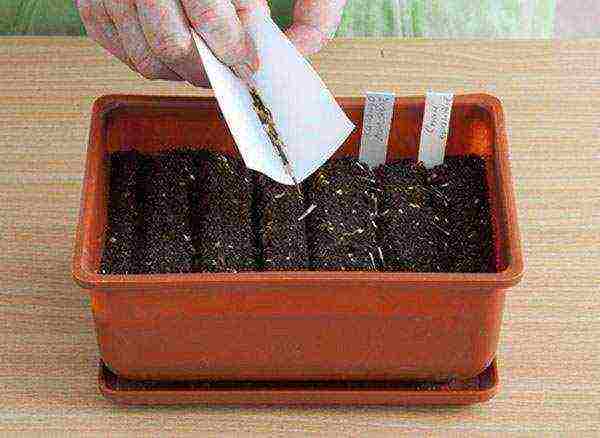
The most reliable way to get flowering plants in the early stages is to plant marigolds on seedlings. Like the main seedlings - peppers and eggplants, they are sown at the end of February - in March. More exact dates depend on the climate and region of residence.
The soil for sowing marigolds is prepared in the following proportions:
- 1 part compost;
- 1 part peat;
- 1 part of garden land;
- 0.5 parts of sand.
 A drainage layer is poured onto the bottom of the tank - broken brick, expanded clay, coarse sand. Then - the prepared soil mixture. It is lightly compacted and watered. A drug against fungal diseases can be added to the water for irrigation, since Tagetes seedlings often suffer from black legs. A few days later, when the earth settles and is evenly saturated with moisture, grooves are made and marigold seeds are laid in them.
A drainage layer is poured onto the bottom of the tank - broken brick, expanded clay, coarse sand. Then - the prepared soil mixture. It is lightly compacted and watered. A drug against fungal diseases can be added to the water for irrigation, since Tagetes seedlings often suffer from black legs. A few days later, when the earth settles and is evenly saturated with moisture, grooves are made and marigold seeds are laid in them.
 Sprinkle with earth on top and moisten a little more. The pots are covered with glass or foil and placed in a warm, bright place. The cover is regularly removed for ventilation. After the first shoots appear, the film is removed and the containers are moved to a sunny place. Water very sparingly until the seedlings develop their first true leaves to prevent blackleg disease.
Sprinkle with earth on top and moisten a little more. The pots are covered with glass or foil and placed in a warm, bright place. The cover is regularly removed for ventilation. After the first shoots appear, the film is removed and the containers are moved to a sunny place. Water very sparingly until the seedlings develop their first true leaves to prevent blackleg disease.
Caring for seedlings at home is no different from the agrotechnology of growing seedlings in the open field: timely watering, feeding and good lighting will allow you to get the first marigold flowers in June.
Planting seedlings in open ground
 The optimal distance between plants when planting marigold seedlings in open ground is 0.4–0.5 m for upright varieties. Low-growing ones can be planted a little more often. The place should be sunny, without stagnant air.
The optimal distance between plants when planting marigold seedlings in open ground is 0.4–0.5 m for upright varieties. Low-growing ones can be planted a little more often. The place should be sunny, without stagnant air.
Plants are transplanted together with a clod of earth. Before planting, marigolds should be watered so that the roots do not dry out during transplantation. It is advisable to prepare a place for the future flower bed in the fall - to add phosphorus-potassium fertilizers, ash and dig it up. When planting seedlings in the ground, compost, carbamide or saltpeter are added under each root. But you should not be zealous with nitrogen, so that the plants do not grow fat, that is, they do not increase the green mass to the detriment of flowering. Spraying with a solution of micronutrient fertilizers for flowers will be of great benefit to velvet flowers. This is done after the plants have taken root, started growing and began to pick up buds.
Outdoor Tagetes care
 Marigolds are hygrophilous, but do not like long stagnation of water. Therefore, watering should be moderate. After watering, the ground must be loosened. For abundant flowering, the flowers are fed several times per season with infusion of mullein or liquid fertilizer from nettle and other weeds.
Marigolds are hygrophilous, but do not like long stagnation of water. Therefore, watering should be moderate. After watering, the ground must be loosened. For abundant flowering, the flowers are fed several times per season with infusion of mullein or liquid fertilizer from nettle and other weeds.
To maintain a high decorative effect, wilted inflorescences are cut off. It is easy to thin out thickened areas by pruning using cut flowers for bouquets.
Diseases, treatment and prevention
 Due to the content of phytoncides, marigolds are less susceptible to diseases than other crops. However, unsuitable conditions for them can cause gray rot disease and an invasion of spider mites. Specimens that are sick with rot are destroyed, in healthy ones, watering is reduced, and they are sprayed with anti-fungal drugs.
Due to the content of phytoncides, marigolds are less susceptible to diseases than other crops. However, unsuitable conditions for them can cause gray rot disease and an invasion of spider mites. Specimens that are sick with rot are destroyed, in healthy ones, watering is reduced, and they are sprayed with anti-fungal drugs. 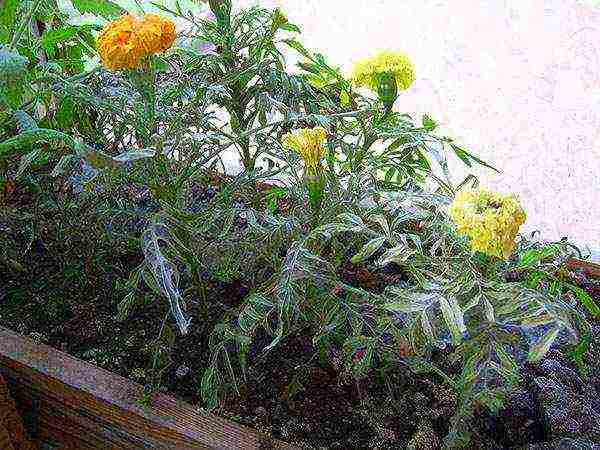 From spider mites, tagetes are treated with infusion of garlic, wormwood, red pepper or tobacco dust. In case of severe damage, the plants are sprayed with solutions of the preparations "Actellik", "Fufanon", "Antiklesh", "Fitoverm".
From spider mites, tagetes are treated with infusion of garlic, wormwood, red pepper or tobacco dust. In case of severe damage, the plants are sprayed with solutions of the preparations "Actellik", "Fufanon", "Antiklesh", "Fitoverm".
Plant marigolds in sunny, blown places that do not thicken, and the plants will bloom more abundantly and less pain.
How to collect and store marigold seeds
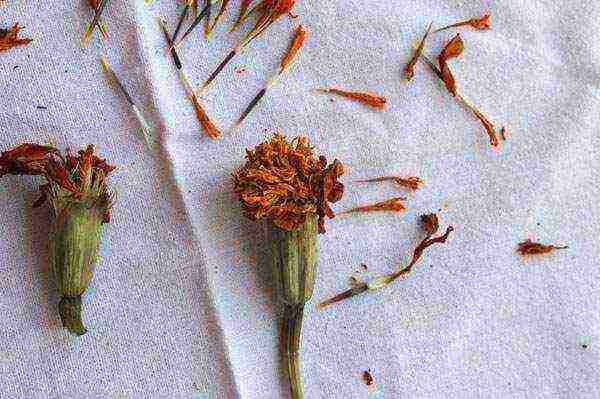 With good care in the open field, marigolds planted in May-June, by mid-August, form faded and dried achenes filled with seeds. They are quite large and resemble an arrow with a black tip and light plumage. The largest specimens are collected for seeds. The collected achenes are dried in a dry place and cleaned, freeing from the husk.
With good care in the open field, marigolds planted in May-June, by mid-August, form faded and dried achenes filled with seeds. They are quite large and resemble an arrow with a black tip and light plumage. The largest specimens are collected for seeds. The collected achenes are dried in a dry place and cleaned, freeing from the husk.
Seeds are harvested only from varietal marigolds, hybrids are not suitable for this, since they inherit the traits of only one of the parents.
Well-dried seeds are poured into fabric bags and stored at a temperature of 1–5 ° C and a humidity of 50–60%. In such conditions, the planting material does not lose its germination for several years.
Application in medicine
 A bouquet of cut marigolds heals the air in the room, scares away flies. Dried petals are used as a condiment in some countries. In the Caucasus, it is known as Imeretian saffron. Leaves treat constipation, fever, used as a diuretic and diaphoretic. In large doses, marigold leaves act as an emetic. The lutein contained in flowers reduces the likelihood of developing cataracts and improves visual acuity. Baths with Tagetes infusion relax, relieve anxiety. They are recommended to be taken before bedtime for depression and neurosis. Tincture of the plant copes well with stomatitis and skin diseases.
A bouquet of cut marigolds heals the air in the room, scares away flies. Dried petals are used as a condiment in some countries. In the Caucasus, it is known as Imeretian saffron. Leaves treat constipation, fever, used as a diuretic and diaphoretic. In large doses, marigold leaves act as an emetic. The lutein contained in flowers reduces the likelihood of developing cataracts and improves visual acuity. Baths with Tagetes infusion relax, relieve anxiety. They are recommended to be taken before bedtime for depression and neurosis. Tincture of the plant copes well with stomatitis and skin diseases.
On an industrial scale, marigolds are grown to obtain essential oils.
The raw material for it is the entire aboveground part of the plants. The oil has a sweet fruity aroma with a light citrus note. It has a sedative, antifungal, hypotensive, antiseptic effect. It softens the skin well, at the same time scaring away flying flies and mosquitoes. Helps heal cuts, scrapes, softens calluses.
Marigold oil is a popular ingredient in many French perfumes.
Benefits for the garden and vegetable garden
 In order for marigolds to fully show their phytoncidal properties, they are planted along the perimeter of the site, along the paths, and the beginning and end of the beds are designated by separate bushes. Tagetes, planted next to cabbage beds, scares off the cruciferous flea. One or two flowering bushes in a greenhouse can significantly reduce the likelihood of tomato disease with late blight and various rot. In autumn, the whole plant is used as a green manure - they grind and dig up the ground together with the resulting green mass. This will scare away the nematode, wireworm and enrich the soil with organic matter.
In order for marigolds to fully show their phytoncidal properties, they are planted along the perimeter of the site, along the paths, and the beginning and end of the beds are designated by separate bushes. Tagetes, planted next to cabbage beds, scares off the cruciferous flea. One or two flowering bushes in a greenhouse can significantly reduce the likelihood of tomato disease with late blight and various rot. In autumn, the whole plant is used as a green manure - they grind and dig up the ground together with the resulting green mass. This will scare away the nematode, wireworm and enrich the soil with organic matter.
Marigold bushes can be left for the whole winter. Planted in rows, they will serve as wind protection and hold snow on the site.
In the spring, after the snow melts, the dried bushes are pulled out and burned, or sent to compost.
Types of Tagetes
 In summer cottages, marigolds of different heights grow, differing in terms of flowering, size and color of flowers. Seeds of your favorite variety and type can be bought in almost any specialty store.
In summer cottages, marigolds of different heights grow, differing in terms of flowering, size and color of flowers. Seeds of your favorite variety and type can be bought in almost any specialty store.
Erect marigolds (Tagetes erecta)
In terms of shape, the inflorescences are divided into two groups:
- clove-flowered - this group has many reed flowers in inflorescences, few tubular flowers in the center;
- chrysanthemum-flowered - the entire inflorescence consists of tubular flowers, along the edge of one row of reed flowers.
Erect varieties of Tagetes are among the highest. Among them there are many beautiful, with large globular inflorescences of yellow and orange flowers.
Antigua - low bushes are strewn with many yellow-orange flowers up to 10 cm in diameter.
Yellow stone - a plant up to 70 cm high looks like a chrysanthemum with large light yellow spherical flowers.
Gold dollar - tall bushes with large dark green leaves beautifully set off red-orange odorless terry balls.
Golden light - compact plants of medium height topped with bright orange lights. Late variety, blooms from late June until frost.
Lemon Prince - from the beginning of summer to cold weather, it will delight you with a combination of lemon-yellow inflorescences with dark emerald carved foliage. The variety is 80 cm high.
Shaggy Robin - the pale yellow heads do look shaggy due to the tubular flowers of different lengths. They look beautiful and unusual when cut.
Rejected marigolds (Tagetes patula)
 This species is of average height - 20–40 cm. Flowers may not be double, but no less beautiful, often two-colored.
This species is of average height - 20–40 cm. Flowers may not be double, but no less beautiful, often two-colored.
Gold head - low, strongly leafy bushes covered with many yellow inflorescences with red edges. The outer petals are wavy and bent down. The variety is recommended for growing in containers, pots, flower beds and flower beds.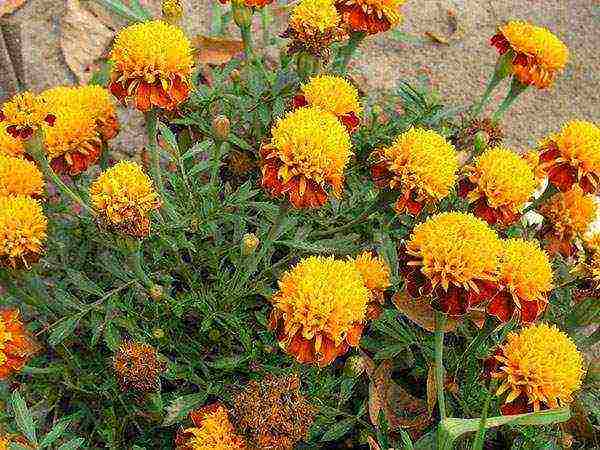
Golden ball - Sprawling branchy bushes will delight you with an exquisite combination of a golden center in a red-brown border. Blooms from early summer. The variety is good for cutting.
Queen Sofia - red-brown shades of terracotta, cinnamon and bronze fade slightly in the sun, acquiring almost chocolate tones. Inflorescences are non-double, but large.
Lemon Jewel - the name of the variety speaks for itself. Compact strongly leafy bushes firmly hold a scattering of double bright yellow flowers.
Orange flame - the variety will not leave anyone indifferent due to the two-color spherical inflorescences with a bright orange center in a red-brown design.
Fine marigolds (Tagetes tenuifolia),
 Thin-leaved varieties have thin, strongly cut foliage and small non-double flowers of yellow, orange or red flowers. Flowering bushes resemble fishnet balls, dotted with many bright lights.
Thin-leaved varieties have thin, strongly cut foliage and small non-double flowers of yellow, orange or red flowers. Flowering bushes resemble fishnet balls, dotted with many bright lights.
gold ring - a plant of medium height with fragile shoots and small light green leaves. It blooms from the beginning of June with bright yellow small flowers with dark orange edging.
Dwarf - similar to the previous variety, but differs from it in its small height. Therefore, it is recommended for decorating the edges of flower beds, rabatok. Beautiful and convenient for growing in pots and boxes.
Lulu - the variety is distinguished by abundant flowering. The spreading bush forms a green ball, strewn with bright yellow stars.
Paprika - a lot of fiery red flowers with a yellow center will not go unnoticed in any flower bed. The variety repels pests with a strong aroma.
With such a variety of varieties, you can make an elegant and long-flowering flower bed only from marigolds alone, alternating different colors. Tall large-flowered varieties are placed in the center of the flower bed, framing them with low-growing varieties of a contrasting shade. Velvets planted in balcony boxes will fill the apartment with a delicate spicy aroma all summer long.
The most important thing about marigolds - video

Marigolds are a wonderful plant, which, with proper and, moreover, completely simple care, can please any, even an inexperienced gardener / florist, with abundant flowering.
It will decorate both a small flower garden and any home, bringing a touch of comfort and orange joy.
Next, we will talk about the features of growing marigolds at home, about the methods of their reproduction, as well as about possible diseases.
…
Description of the plant
Marigolds can be both annuals and perennials. South America is considered their homeland. They are presented in the form of a bush with a height of 30 to 130 cm, consisting of erect, rather strong stems. The root system of the plant is fibrous, the leaves are pinnately dissected.
Marigolds bloom with luxurious rounded baskets of various shades of orange, yellow and brown.
On a note. The duration of flowering is quite long: from the first month of summer until the onset of the first autumn / winter frosts.
What is noteworthy, the seeds of the plant can self-sow and retain their germination for several years.
Growing
Marigolds are a very unpretentious plant, therefore, they can be grown not only at home, but also in the open field.
 Since marigolds perfectly tolerate cold and even frost, they can be planted immediately to a permanent place without covering, because the young sprouts of marigolds do not need protection at all.
Since marigolds perfectly tolerate cold and even frost, they can be planted immediately to a permanent place without covering, because the young sprouts of marigolds do not need protection at all.
When determining the optimal time for planting a plant, you should focus solely on the weather conditions: when planted in open ground, the air temperature at night should be above +5, if the plants will "live" at home, planting can be carried out throughout the spring.
When growing marigolds at home, you should provide the plants with a sufficient amount of sunlight. Immediately after sowing / planting, marigolds should receive not only natural, but also, if necessary, additional lighting. They are very fond of sunlight, so do not be afraid to leave the plant in the open sun: it will only be happy about this and will definitely respond with lush flowering.
Marigolds are very fond of nutritious light neutral soil, therefore, it is advisable to plant in such a soil. If it is not as fertile as necessary, you will have to increase the amount of dressings.
Important! Marigolds will feel quite comfortable in the shade and will certainly grow, but they will hardly be able to wait for flowering from them.
Since in most cases, marigolds are annuals, after flowering they are simply pulled out of the ground. If you want to use them for growing next year, carefully collect the seeds and store them (you can plant them again when spring comes).
Reproduction methods
At home, it is best to cultivate marigolds by the seed method. To do this, first of all, you need to collect seeds from previous plants: you need a faded bud (or you can buy ready-made seeds).
- The soil for sowing seeds must be thoroughly warmed up. First mix it with a little sand and pour it into a growing container (it must have a drainage layer). Put it in a very warm place (you can even have a battery) for high-quality heating.
- Before sowing, the seeds are soaked for 15 minutes in a weak manganese solution, after which they are thoroughly dried.
 In the heated soil, small grooves are made with a depth of about 1 cm. The seeds are sown at a distance of about 2-3 cm from each other. Since the seeds are very small, you should carefully sprinkle them with earth and sprinkle with water from a spray bottle. Then cover the pot with plastic wrap and place it on a windowsill in a room with a temperature of at least +22 degrees.
In the heated soil, small grooves are made with a depth of about 1 cm. The seeds are sown at a distance of about 2-3 cm from each other. Since the seeds are very small, you should carefully sprinkle them with earth and sprinkle with water from a spray bottle. Then cover the pot with plastic wrap and place it on a windowsill in a room with a temperature of at least +22 degrees.- The first shoots should appear in a few days. Immediately after that, you can remove the film and move the pots to a cooler place with a temperature of about +18 to strengthen the young seedlings.
- When the height of the marigolds reaches the 4 cm mark, you can pick into separate pots. Immediately after transplanting, the plants are gently watered with warm water.
- A couple of days after transplanting, be sure to feed young plants with minerals (root feeding), and after a couple of days - fertilizer for the green part of the plant. Before the first flower ovaries appear, try periodically spraying the seedlings with warm water.
Note! Before transplanting into a separate container, it is advisable to pinch off a small part of the root from the plant: this will stimulate it for active growth.
Care rules
In order for marigolds to delight you with their beautiful flowering, it is necessary to provide them with proper care, which is most often represented by the following procedures:
- Watering. Watering should be of high quality and regular.If the plant is grown at home, it should be watered daily (in especially hot weather - twice a day), but you should not fill it with an earthen lump so that there is water. During the flowering period, watering stops, otherwise you can provoke rotting of the root system, which will lead to the death of the plant.
- Top dressing. Since the soil in pots and any other closed containers is quickly depleted, it is necessary to provide the plant with high-quality, timely feeding. Marigolds respond well to complex fertilizers for flowering plants. The first time the fertilizer is applied when the plant reaches 10 cm in height, the second time - when the first buds appear and, finally, the last time - when the flowering begins.
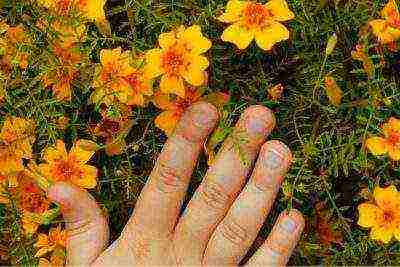 Soil processing. The root system of marigolds is very fond of "breathing", so it is important to provide oxygen to the roots of the plant. To do this, loosen the top layer of soil in the pot with a small spatula, sticks or a cultivator at least once a week. Believe me, the plant will react only positively: it will begin to grow faster and, possibly, bloom earlier.
Soil processing. The root system of marigolds is very fond of "breathing", so it is important to provide oxygen to the roots of the plant. To do this, loosen the top layer of soil in the pot with a small spatula, sticks or a cultivator at least once a week. Believe me, the plant will react only positively: it will begin to grow faster and, possibly, bloom earlier.- Pruning. If the bush grows bulky enough, you can trim some of the stems, giving the plant the desired decorative appearance. It is also advisable to remove faded inflorescences in a timely manner: this will stimulate the rapid appearance of new ones.
Diseases and pests, possible problems
Marigolds very rarely get sick, but in some cases they may still be negatively affected by pests or various ailments. So, a plant can hit gray rot, revealing itself in the form of a white bloom on the stems and leaves, turning over time into gray fluffy spots. Fighting the disease is extremely difficult. The simplest option is to remove diseased plants immediately so that they do not infect others.
In very dry summers, spider mites can appear on marigolds. You can eliminate it by spraying the plant periodically with onion infusion or pepper (infusion of red hot pepper). You can avoid the appearance of the pest by increasing the humidity level in the room with marigolds at least several times a week (spray water from a spray bottle near the plants).
It is also important to properly care for the plant in order to avoid possible problems.
Attention! With regular waterlogging of the soil, fungal diseases can occur that will destroy the root system of the plant, so observe the measure. And an insufficient amount of moisture in the soil can lead to a slowdown in the growth of marigolds.
Do not overfeed marigolds in the spring, combining this process with sufficiently high indoor temperatures: this can lead to rapid growth of green mass and poor flowering.
That's all the subtleties you need to know for growing marigolds at home. Follow these simple care guidelines and you can grow a strong, healthy plant. Good luck!
Useful video
Marigold. Growing and care:
Well, who has not heard about the chernobryvtsy loved by our mothers and grandmothers - marigold flowers? They decorate flower beds, delight the eye in squares and parks, frequent guests in the garden, palisade, adjacent to the territories of shops. Marigolds are very famous for their varied bright colors, they have a pleasant specific smell, which is not liked by many garden pests, insects.
The area of application of this plant is very wide: they are used to decorate decorative panels on the walls of facades of houses, loggias, balconies, and also grow well in flower beds, in flower beds. Look good when decorating a decorative landscape in the architectural design of the design of sites.
How to grow marigolds?

How to plant marigolds on seedlings correctly photo
Marigolds are very picky about care, it is not for nothing that the fame of one of the most unpretentious flowers that are grown artificially has strengthened behind them. They can grow on any land.But they love bright places, waterlogging of the soil is undesirable. Watering is not frequent, which can be combined with fertilizing with mineral fertilizers, diluting fertilizers in water.
Gardeners often practice planting marigolds between the beds or near the greenhouse.
- Having a specific smell, this plant repels harmful insects. Marigolds can grow in flower beds, special containers, flowerpots and even shallow pots decorating walls or loggias.
All varieties of flowers can be sown in open ground with seeds. To do this, it is best to purchase seeds at specialized retail outlets. With further breeding, there will be enough of those seeds that are called after seed ripening. But be sure to take into account: if you use the seeds of the same plants for several years, they may lose the properties of the original variety, and will not look like the variety that you purchased.
Sowing and growing can be done in two ways:
- pre-grown seedlings;
- sowing seeds directly into the ground;
The choice of growing method may depend on growing factors: what time the flowers are needed, the duration of flowering, the required amount, weather conditions and growing conditions.
When to plant marigolds in open ground? Remember: night temperatures should not drop below 5 degrees. This is usually the end of April in regions with a mild climate. You can plant seedlings in open ground until the end of May and the beginning of June.
How to plant marigolds by seeds in open ground

Planting marigolds Marigolds growing from seeds when to plant
When to plant marigolds in the ground with seeds? It all depends on the climate, the main thing is that there are no frosts at night and the soil is ripe. Keep in mind that the seeds of the Chernobryvians are not afraid of frost, and can even overwinter or endure sowing before winter. They just won't rise before the earth warms up. Still often worried about how many marigolds sprout. If the weather is warm, you have to wait two to three weeks before the first shoots appear.
We sow like this:
- The embedment depth is small, you can make grooves with a hoe or small holes, up to 5 cm deep.
- They strive to make the distance no closer than 10-15 cm between plants. But you can also sow with a continuous ribbon, and then transplant excess plants.
- Cover the seeds with earth using a rake.
- Watering.
On this, all the wisdom is over. However, you can speed up the flowering a little and improve the conditions of detention, more on that below.
When sowing marigold seeds outdoors, consider the conditions that are necessary for the growth of young plants. Namely: the site should be well lit, they certainly endure the shade, but still do not like it, reacting with a decrease in the abundance of flowering and stretching the bushes, which suffers from their decorative effect.
To get marigolds without seedlings ...
- In the garden, they often strive to prepare a fertile soil mixture well fertilized with mineral and organic fertilizers, but there is no urgent need for this: the flowers are so unpretentious that they can grow on the poorest soils, it is enough just to provide them with the necessary amount of moisture.
- They respond very well to watering, but drying out of the soil is fraught with troubles: the lower leaves dry out, and the bushes themselves stop growing, flowering is meager, inconspicuous.
- Flowers will bloom only one and a half to two months after sowing, this should be taken into account. Early sowing (mid-April) and seed germination before planting will help to slightly reduce the time before blooming and increase the flowering time. This is the method used by experienced florists.
To do this, it is enough to place the seeds in a shallow plate, cover with damp gauze rolled in several layers, place in a cellophane bag or wrap with transparent film. After completing these procedures, place the plate in a warm, sunny place: one of the suitable places is the windowsill.
After two to three days, the seeds can be sown, having previously examined them for germination, healthy seeds should be with a swollen and slightly cracked peel. You can lightly dry the seeds in the sun for two to three hours until flowing or not wait, but mix with dry sand and sow with it.
Before planting, it is necessary to moisten the soil, make holes or grooves with a depth of 4-5 cm. It is best to sow seeds in a square-nesting way, that is, the distance between the seeds should be 15-20 cm in a square. After the seeds have sprouted, thinning should be done, leaving the healthiest seedlings.
For those who do not like unnecessary actions ...
- it is quite possible to be limited to simple sowing of seeds in rows without any preparation and soaking. Chernobryvtsy will still rise and develop perfectly. Just a week or two later. But do not be lazy to water, no flowers grow without moisture!
How to grow marigold seedlings from seeds at home
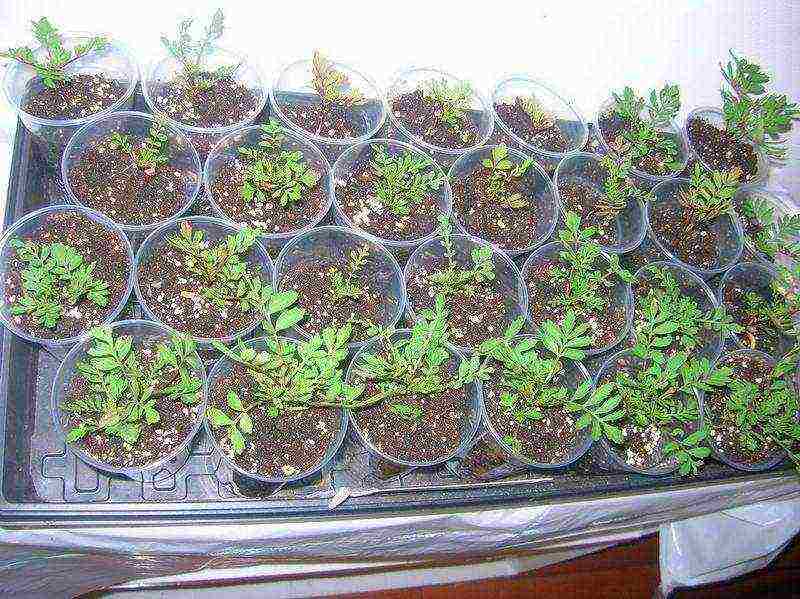
Planting marigolds for seedlings When to plant marigolds
When to plant marigolds for seedlings? To get flowering plants in June, it is necessary to prepare the seedlings in advance, which will be planted immediately after the end of the night frosts. Sowing dates begin from the end of February and are shifted until the end of March or mid-April.
You can prepare a nutritious soil mixture in the fall. Peat, turf soil, humus and sand are mixed. River sand can be used, but before adding it to the soil mixture, it is advisable to calcine it in the oven or treat it with potassium permanganate.
However, you can not bother yourself and just buy a ready-made flower substrate in which you can grow beautiful seedlings with strong trunks and spreading leaves.
How to grow seedlings of black-brewers on the windowsill:

How to plant marigold seeds for seedlings photo
- The needle seeds are easy to distribute evenly in the planting container, it is better to leave a distance of 3-4 cm so that the plants turn out to be powerful. Embedding depth 1 cm, two can be.
- You can immediately plant the seeds in separate cups, which will further simplify the task of transplanting to a permanent place. Marigolds get sick longer when the roots are damaged than the same asters, so it is better not to disturb them once again. However, even wilted bushes are accepted over time and take root perfectly.
- For quick germination, you can cover with foil or glass, creating a greenhouse effect. Marigolds take a long time to sprout, so be patient.
- When we see the first shoots, we open the greenhouse.
- You need to water regularly, but not be zealous, so that rot does not develop and the seedlings do not die. A simple moistened state of the soil is enough.
- Do not overheat the air in the room where the seedlings are growing. The temperature should be less than 25 ° C.
- If you notice that the seedlings are elongated and have a pale color, it means that they have little light. You need to choose the sunny side of the apartment or arrange additional lighting.
- If you really want to try, water the seedlings 1-2 times with a solution of complex fertilizer for flowers, with an interval of 10 days.
- Before planting, in a couple of weeks, we begin to harden the seedlings, accustoming them to the sun, wind and coolness. Take it to the balcony, loggia, threshold of the house. We gradually increase the time spent on the street, so that by the time of planting the plants are fully accustomed to the street.
At a height of 10-15 cm, marigold seedlings are ready for transplanting into open ground.
How to sow marigolds for seedlings video:
As you can see, everything is simple: the seeds are large enough, which allows you to plant them one at a time in cups and simply water them without unnecessary hassle until it is time to transplant the seedlings to a permanent place.
Here's another interesting way: sowing marigolds in a snail on paper, the video will tell about this:
Well, probably even the laziest florist will find an acceptable way for himself and will grow black-cutters for his flower bed!
Planting marigold seedlings in open ground

How to plant marigolds in open ground
It's very simple:
- We prepare shallow holes so that a clod of earth fits completely in them.
- You can pre-pour water and put a handful of humus on the bottom.
- Carefully release the seedlings from the cups, set them vertically, sprinkling with soil.
- We water so that the soil subsides, but the water does not stagnate.
- You can immediately grind the surface with what is at hand. These can be last year's leaves, fresh grass, hay or needles from the forest.
- The distance between the holes depends on the selected variety. For low-growing varieties, 10-15 cm is enough, for medium and tall varieties, leave more space, about 30-40 cm.
Chaotic landings look original, creating an unpretentious naturalness. We are all accustomed to rows for a long time, they look boring and familiar. Create a composition, for example, planting petunias in the foreground, and chernobryvtsy in the background.
Another video on how to grow marigold seedlings, plant them in the ground and take care of flowers:
A luxurious flower bed that does not require much maintenance? Now you see that it's easy with marigolds!
Outdoor care
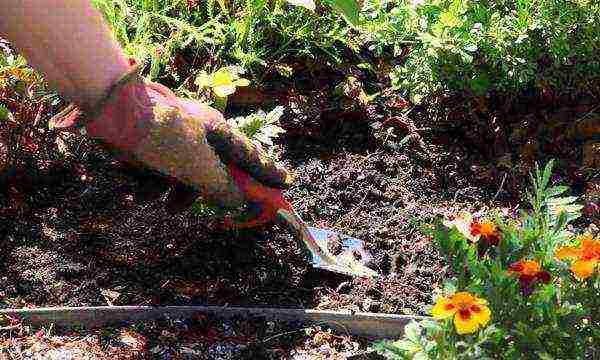
Flowers marigolds planting and care in the open field photo
Plants are not demanding to care for and do not require special costs and efforts. However, perhaps, like all cultivated plants, watering and weeding from weeds and soil cultivation in the form of loosening are required.
How to water
Watering is necessary in moderation, but you cannot do without it, otherwise your flower bed will be covered with dried brooms, only the tops of which will retain a fresh look. Especially if it's a hot summer. Do not rely only on rain, water at least once every three days, remembering to loosen the ground after watering to conserve moisture. Simultaneously with watering, fertilizing can be carried out by diluting mineral and organic fertilizers in water.
In summer, when the weather is hot, watering is best done in the morning or evening after sunset to prevent crusting on the ground. If watering is done during the day, then it is imperative to loosen the top layer of the earth.
Foliar and root feeding
If the land is prepared correctly before planting, then the marigolds do not need additional feeding. If, on the other hand, it is clear from the plant that the development is not going well, it is possible to fertilize with complex fertilizers on the leaves.
The use of fresh organic matter is not recommended. It is better to ferment the same grass or manure for a couple of weeks and dilute with water in a ratio of 1:10, pouring a liter of solution under each bush.
It must be remembered that an overdose of fertilizers has a detrimental effect on plant growth. Mineral fertilizers are applied for the first time during the period of intensive plant growth, the second time when the first buds appear, and the third time before flowering.
Formation of bushes
Very rarely does anyone bother with this at all. However, if you have time, you can give the marigolds a beautiful shape. Prune some additional branches off the main stem. This procedure will noticeably improve the nutrition of the remaining buds. The optimal pruning time is summer, when you can already see how the buds are opening. Also, buds with signs of any disease, small or wilted, are cut off. After the formation of the bush, the appearance of new additional branches of the stem is suspended.
Seed collection
For planting next year, it is enough to use seeds that can be collected from flowers grown on the site. To do this, it is enough to choose a bright and healthy bush, let it ripen completely, then cut the buds and dry them. After which the seeds are easily separated, they can be stored in a paper bag. When using this method, it must be borne in mind that this will not affect the health of the plant itself, but you can get a different color of the baskets, different from the mother.
Pests and the fight against them
Due to its natural properties, the plant not only protects itself from various infectious diseases, but also covers the surrounding area with special essential oils (expressed by a specific smell), which has antiseptic properties.Using this property, gardeners and gardeners plant marigolds next to vegetable beds and greenhouses, or in combination with other flowers.
Slugs and snails
To combat them, you can use special preparations that are purchased in stores, or use an old recipe: sprinkle the edges of the garden bed, if possible, the entire bed, with dry ash. Having previously collected all the snails and slugs from the beds.
Spider mite
When a spider mite appears, it is best to eliminate the plants immediately in order to prevent the spread of the disease to other bushes; for the prevention of the disease, in addition to special preparations, you can use folk recipes, for example, a mixture of yarrow with onion infusion.
Gray rot
This disease most often appears in wet weather, when morning fog sets in and the earth does not have time to dry out. If this disease is detected, the plants must be removed and burned. the place must be treated with potassium permanganate, or spilled with boiling water, otherwise there will be a risk of infecting all plants and not only marigolds.
Marigolds in landscape design photo

Marigolds look very beautiful in compositions with ageratum
To decorate a personal plot or flower bed, these flowers can be used in a wide variety of combinations.

Petunia and marigolds look beautiful photo
This is all the more pleasant, because: unpretentious care, different bright colors, difference in growth height, abundance of color, long flowering period can be used almost indefinitely.

Beautiful marigolds photo compositions
Marigolds are great in single plantings and combined, they are planted in parks, on the curbs of footpaths, flowerpots for various recreation areas. They are used to decorate balconies and loggias or even billboards, front walls of houses.

Marigolds in the garden photo flower beds
Experienced gardeners recommendations
Some flower growers recommend different dates for planting seeds for seedlings. In their opinion, tall varieties are suitable for the earliest planting date (about March), in April it is necessary to sow seeds of low-growing crops. Another option worthy of attention is the purchase of seedlings in specialized stores, which you can find out about in Internet sources.
When purchasing seedlings in specialized stores or special nurseries, the seedlings are sold already germinated in special peat cups. Before planting, it is necessary to look at each leaf for damage or any foreign brown spots. Be sure to ask the seller about the conditions for planting and growing these seedlings, as they may differ from those described above.
Marigold varieties with photo names and descriptions
Marigold erect or African Tagetes erecta

Marigold erect or African Tagetes erecta photo
Representatives of this species are annual plants that reach a height of up to 120 cm, some species grow only up to 30 cm. This seemingly disadvantage is used by gardeners to create the illusion of an endless field of flowers.
Flowers of various heights in compositions are good in flower beds, flower beds or specially created areas with a sufficient amount of land. Large baskets of flowers look good in bouquets. The stem on which the buds are held is tough and sturdy.
Cirrus leaves are arranged alternately, have a light green or green color. The flower buds are mostly terry, spherical in shape, monochromatic shades from bright yellow to deep orange with dark edging. The species is not picky about care, has good resistance to low temperatures and various diseases.
Varieties of erect marigolds:

Marigolds erect variety Antigua photo
Antigua - baskets in diameter from 8 to 10 cm. Bright yellow or orange. Refers to low-growing varieties: the average flower height is from 20 to 30 cm.

Marigolds erect grade Kilimanjaro photo
Kilimanjaro - a distinctive feature of this species is light petals of flowers, there are white with cream shades. They grow up to 70 cm.

White marigolds erect grade Eskimo photo
Popsicle - this kind of "Marigolds" have white buds. Differs from Kilimanjaro in short stature. Grows up to 30 cm.

Marigold erect Aztec Lime Green photo
Aztec Lime Green - Marigolds with a shade of bud petals between white and brown. The variety is medium-sized.
Marigold rejected

Marigolds rejected terry Carmen planting and care photo
One of the distinctive features of this species is the presence on the stem of numerous shoots with small spherical baskets. It is this structure of the stem that makes it spreading.
The height of a bush of this variety reaches 20 or 40 cm, that is, it can be different in height and volume of flower baskets.
The color palette of the buds can be two-color, usually in the middle of the flower is yellow towards the edges there is a color change to yellow or red.
Varieties of rejected marigolds popular in Russia:

Marigold Lemon Jam Photo
Lemon jam - short, well-branched bushes with bright yellow, lemon flowers.

Marigolds rejected variety Carmen photo
Carmen, undersized variety up to 20 cm, bush well. The flower buds are small, up to three to four centimeters, the yellow core smoothly turns to dark red along the extreme petals.

Marigolds rejected variety Queen Sofia photo
Queen Sofia... A distinctive feature is dark red petals, the edges shimmer with a bronze color, in the form of the extract, they are weakly double, they are distinguished by red petals, which have a faint shade of bronze at the edges. One row of petals in shape, inflorescences are weakly double.
Thin-leaved sheep Tagetes tenuifolia

Tagetes tenuifolia thin-leaved ragweed photo of the name of varieties with descriptions
This is a less common variety of marigolds, but its difference from the rest is so great that it seems that this flower is a completely different species. The difference is that the trunk is very branching, and the baskets can be of different colors. Additional attractiveness is created by the leaves, which are carved, long, narrow leaves in the rosettes of which small multi-colored flowers are beautifully attached. The height of the trunk reaches 30 - 40 cm. The flower itself is small and resembles a chamomile in shape, there are many of them on the bushy trunk, which creates a uniquely beautiful bouquet. Petal colors range from bright yellow to red or purple.
Varieties of fine-leaved marigolds:

Marigold red devil photo
Red Devil - a profusely flowering variety with large blood-red flowers and rich green leaves. The stunning contrast is truly mesmerizing both in single plantings and in combination with colors of white, yellow, blue shades.

Marigolds red gem photo
Red gem - Medium-sized (up to 30 cm) plant with reddish petals framing a bright yellow center. Bloom until autumn frosts. It bushes well, is not demanding in Care.

Marigolds grade Gnome photo
Dwarf... The name itself indicates the low growth of the plant (up to 20 cm), the main trunk has many branches, resulting in a highly branched bush with numerous bright yellow flowers and a red core.
In order for marigolds to grow well, it is necessary to follow certain agricultural techniques when planting and caring for flowers.
Small-flowered marigold Tagetes patula

Small marigolds Tagetes patula ‘Bonanza Harmony’ photo
The name speaks for itself, these are short plants up to 30 cm in height with a scattering of small flowers-baskets on long peduncles. They delight with beautiful flowers from July to the end of August.
Description of marigold flowers, their distinctive features
The plant belongs to the Asteraceae or Asteraceae family.These flowers are mainly grown in gardens, but due to their stunning unpretentiousness, flowers have also become very popular in decorating loggias, and they are also grown on balconies.
Another name for the flower is Tagetes (Tagétes) - This name refers to distant legendary times. Once upon a time in Ancient - Roman mythology, there were many gods. Once one of them, whose name was Jupiter, had a grandson, named Tagetes.

All varieties of marigolds photo and description
The grandson had a divine foresight, a romantic character and was very handsome. When the time came to show the world a beautiful plant rediscovered in South America, the Swedish scientist, renowned naturalist and physician Carl Linnaeus named it by this name of the young god. Indeed, flowers called Tagetes still continue to amaze people with their romantic peculiar beauty.
The plant got the popular name Marigold because of the inflorescences that bloom with bright buds, very delicate to the touch, somewhat similar to velvet scraps of fabric. The birthplace of the flower is considered to be the Central part and the south of America, where the largest number of different species are distributed. In the middle of the 16th century, the Tagetes first went to Europe and then to Russia. The scientific approach to the selection and cultivation of these flowers makes them popular all over the world. Already, seemingly, "Marigolds" can be found in all countries of the world.

Marigolds photo of flowers in a flower bed and in a garden
Marigold itself is a herbaceous plant with flowering buds, a bit resembling small bushes with a large stem and branches in the form of branches extending from it. The height of the stem and the size of the bud are different depending on the variety. There are very small specimens, in contrast to them there are varieties that grow more than a meter. Such a plant looks very good in individual plantings in flower beds and flower beds.
The breeder also managed to breed low-growing varieties with small flower buds, such plants are best suited for decorating external walls, balconies and loggias in hanging flowerpots.
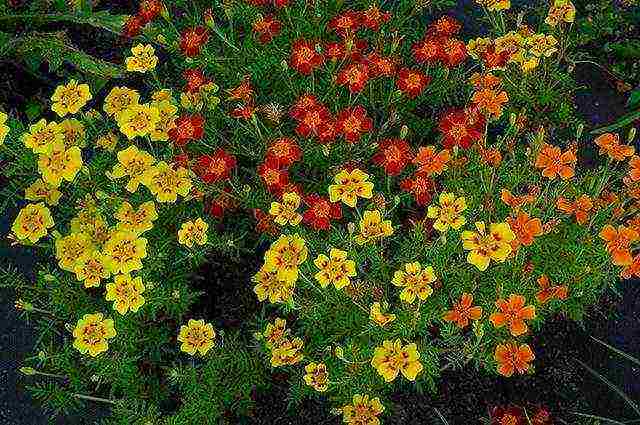
Small marigolds planting and care photo of flowers in a flower bed
The stem is erect or branched, which makes it possible to form a bush of buds standing on one stem, the stems are tough and very strong. The leaves of the plant are feathery or porous - divided. The color of the leaves depends on the composition of the soil and can be bright green or ordinary. The root system is widely branched, fibrous. Inflorescences consist of baskets of various colors and shades. The traditional color for marigolds is considered yellow and burgundy brown along the edges of the petals, with shades of orange, white and red varieties are less common.

Flower beds of petunias and marigolds photo
A basket of flowers consists of two parts: the middle ones are tubular, to the edge the flower is represented by a petal inflorescence. In appearance, the baskets can be simple and terry. Several baskets of different size and color can bloom on one stem at the same time. Duration of flowering, from early summer to autumn frosts. After the basket fades, they have a fruit tied in the form of an achene, resembling the needles of a hedgehog. The seeds retain a high germination capacity, so if they fall into the ground, they can germinate anywhere there is fertile soil.
Marigolds have a specific smell that insects do not like; this property is used by gardeners, planting them along the edges of flower beds or other plantings. Some types of marigolds are used in traditional medicine.


